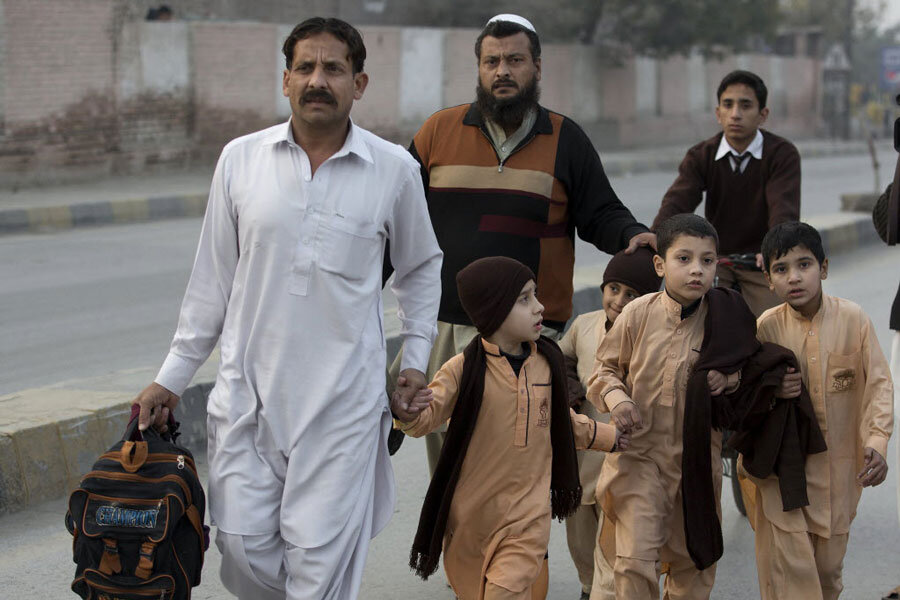Pakistan school attack: Why children are becoming a more common terror target
Loading...
| Washington
Malala Yousafzai, the Pakistani schoolgirl shot in the head by the Taliban in 2012 for speaking out for universal education, is living evidence that attacking children is not a new terrorist tactic.
But Tuesday’s deadly attack by the Pakistani Taliban on a school in Peshawar – an assault that featured suicide bombers and heavily armed gunmen going from classroom to classroom and on to the school auditorium to slaughter dozens of students – is part of an increased willingness by terrorists to target children.
In April, the Nigerian Islamist terrorist group Boko Haram kidnapped hundreds of schoolgirls, an attack that shocked the world but that was only the high-profile tip of the group’s full-on assault on both girls and boys, and on education.
In Kabul, Afghanistan, last week, the Taliban sent a young suicide bomber into a high school auditorium to detonate himself as students watched a modern dance program – one depicting the horrors of suicide bombing. The attack was part of an intensifying destabilization campaign by the Taliban, but one that until Thursday had largely focused on the Afghan military, government officials and buildings, and sites frequented by foreigners.
While using children to get at their parents or the government is not a new terrorist tactic, the mass targeting of children, as seen in Peshawar, suggests that some degree of moral limitation on certain kinds of attacks is falling, some regional analysts say – especially as terrorists look for more stunning and horrific ways to grab the international spotlight.
“This is a massacre, and a massacre of children,” says Daniel Markey, an expert on Pakistan and South Asia at the Council on Foreign Relations in Washington. “That means the barriers to attacking children have gone down, and that does reflect something different.”
Tuesday’s attack at the Army Public School in Peshawar resulted in at least 141 deaths, mostly students spanning elementary and middle school years.
President Obama quickly condemned the “horrific” attack, saying that “by targeting students and teachers … terrorists have once again shown their depravity.”
Depravity is certainly a word many would say applies to the Peshawar assault. But the perpetrators of the rising attacks on children often claim a certain logic – as twisted as it might seem to most – to their actions.
“They’re attacking what they see as the institutions of culture, and in particular the institutions of Western culture,” says Ebrahim Moosa, professor of Islamic studies at the University of Notre Dame in Indiana. “They see that the process of Westernization begins at school, so schools that violate strict Islamic education become targets.”
In the Peshawar attack, an added motivation was “payback time for the Pakistani Army,” Professor Moosa says.
Indeed the Pakistani Taliban, which quickly claimed responsibility for the school slaughter, justified the attack as retaliation for the Pakistani military’s campaign of the past six months against the Taliban in the country’s tribal areas – an offensive the Taliban said has resulted in hundreds of civilian deaths, including of children.
The students at the school were mostly the children of military officers. Add to that the fact that the tribal areas where the military has been on the offensive “have a very strong revenge culture,” and the result is a “lethal combination,” Moosa says.
In the case of Boko Haram in Nigeria, the attacks on schools reflect the group’s belief that Western-style education is un-Islamic. Educating girls in particular is viewed as a sin. Males at all-boys state schools that have been attacked have either been kidnapped to be forced into fighting for the terrorist group, or they have been gunned down as they have fled school dormitories under assault.
In recent months, Boko Haram also has stepped up the use of schoolgirls as suicide bombers.
In both Afghanistan and Pakistan’s tribal areas, the Taliban have long targeted schools, and in particular schools built with Western assistance, as ways of undermining public trust in the government and retaliating for military efforts to subdue pro-Taliban areas, says CFR’s Mr. Markey.
But in this year’s high-profile attacks involving children, Markey says he sees a kind of escalation in terrorists’ efforts to make a mark and egg on opponents to engage in the conflict they seek.
“The ability of any of these groups to attract global attention depends to some extent on how shocking their actions are,” Markey says, “and that means they’re having to find new and more horrific ways to do it.”
A school attack involving dozens of child victims sends shock waves around the world, he says, “but if it had been an attack on an army base somewhere, it’s pretty clear it wouldn’t have got as much attention.”
Notre Dame’s Moosa says terrorist attacks on children have “never been taboo,” but he says the Peshawar attack points to “a greater level of brutality than we’ve seen before.”
The world was shocked when a lone gunman got on a bus in 2012, asked for Malala Yousafzai by name, and then shot the girl who responded in the face, Moosa says. The Peshawar school attack strikes us as even more horrific because of the number of children who perished, he adds, but the motivations were not much different.
“This was a way to punish the parents for not obeying Taliban edicts,” he says, “and the Pakistani Army for coming after them.”






